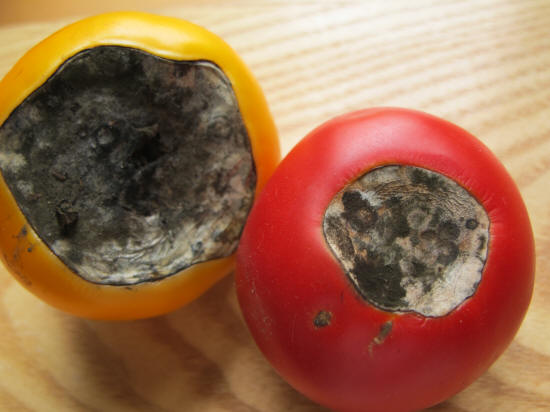|
 This would actually be the second bout for the year. Look for a
shepherd’s crook at the tip of the affected areas as a clue it
is fire blight. Fire blight is a bacterial disease, therefore
there is little chance for you to treat it. The common treatment
in commercial operations is streptomycin, but it has to be
applied before symptoms appear. Copper or Bordeaux mixture can
also help prevent, and that means prevent and not cure, the
disease in some years. Prune out disease cankers when dormant.
The ornamental pears are moderately resistant, but dead tips are
common again this year. These also provide a source of the
disease for other susceptible hosts. This would actually be the second bout for the year. Look for a
shepherd’s crook at the tip of the affected areas as a clue it
is fire blight. Fire blight is a bacterial disease, therefore
there is little chance for you to treat it. The common treatment
in commercial operations is streptomycin, but it has to be
applied before symptoms appear. Copper or Bordeaux mixture can
also help prevent, and that means prevent and not cure, the
disease in some years. Prune out disease cankers when dormant.
The ornamental pears are moderately resistant, but dead tips are
common again this year. These also provide a source of the
disease for other susceptible hosts.
Insects

One insect of note with the wet weather earlier this year is the
earwig. Earwigs tend to be in high organic areas, as they feed
primarily on dead insects and plant material. However, they can,
and do, eat live plant material such as marigolds, zinnias,
strawberries, and others. They may be a prime suspect if you
notice damage, but never see any insects during the day. Control
can be obtained with insecticides such as bifenthrin or
permethrin.

The inconspicuous potato leafhopper has been a problem for the
past week as well. This is the small wedge-shaped, light green
insect that seems to just fog around security and patio lights.
They are also small enough to come in through screens after
dark. They are not only a nuisance, but they can cause damage to
a wide variety of plants.
Potatoes are the first plant that comes to mind when we talk
about potato leafhoppers (must be something about the name), but
many other plants ranging from beans to trees can be affected.
You may be wondering what kind of damage a few little
leafhoppers can do, especially since they suck sap from plants
and aren't that big in size.
Leafhoppers suck sap and then inject a toxin back into the
plant. Along the same lines as humans getting a mosquito bite -
it's the extra that's injected back in that causes the injury.
Symptoms of leafhopper damage start as yellow "v" shaped areas
on the tips of leaves. These areas turn brown or black and then
fall out leaving a "v" shaped hole on the tip of the leaf. This
is a symptom, but not the only injury. Large numbers of
leafhoppers can kill potato and other plants.
[to top of second column] |

Controls for leafhoppers are warranted with very low numbers. In
alfalfa fields, it is recommended to treat when 2 leafhoppers
are caught in a sweep net in alfalfa over a foot tall. Garden
treatment options for potatoes include Sevin, bifenthrin,
permethrin, and rotenone as common insecticide choices available
to homeowners. Most trees and shrubs can be treated with Sevin,
permethrin, or bifenthrin.
Blossom End Rot of Tomatoes

Blossom end rot is a non-infectious disease (caused by the
weather and growing conditions) which is very common during
extended dry periods. It also seems to be worse on tomatoes
grown in containers. The alternating weather patterns we have
experienced have set us up for problems.
It begins as light tan water-soaked lesion on the blossom end of
the fruit. The lesions enlarge and turn black and leathery. This
can drastically lower the yield and lower marketability of the
fruits. Fluctuating soil moisture supply during the dry periods,
and low calcium levels in the fruit are the major causal
factors. Control of blossom end rot consists of providing
adequate moisture from fruit formation to maturity, and use of
mulch (grass clippings, plastic, straw, shredded newspapers, or
plastic) to conserve moisture and even out the moisture supply.
If you don’t have a mulch in place now, it is best to apply soon
to prevent problems. Also, avoid frequent shallow watering.
Water deep and then wait five or more days before watering
again. This is one reason this problem is very common in
container grown tomatoes.
[By JOHN FULTON, COUNTY EXTENSION
DIRECTOR SERVING LOGAN, MENARD, AND SANGAMON COUNTIES]
 |